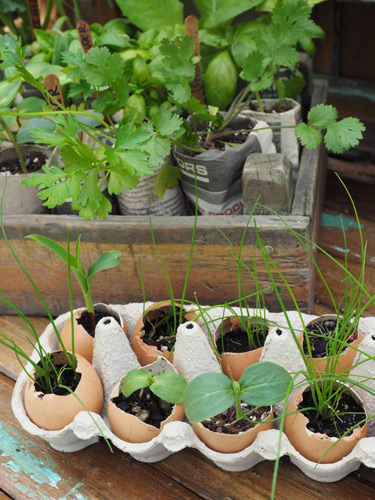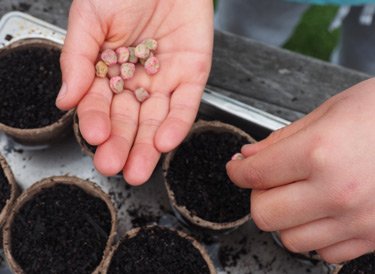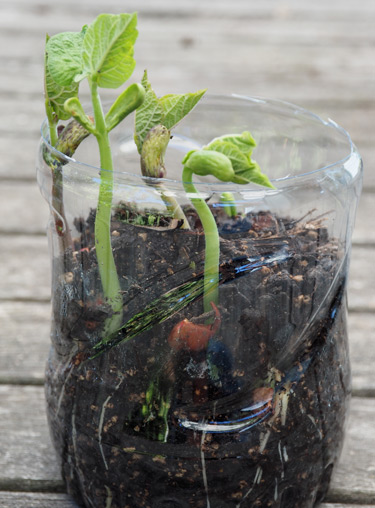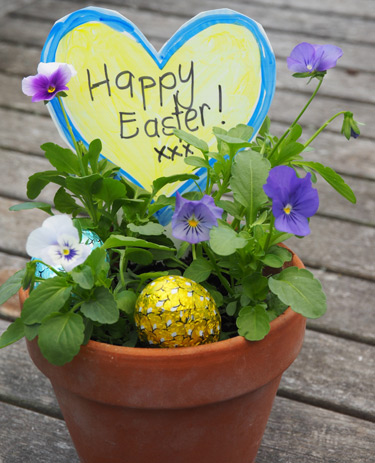Kids Go Gardening - seed sowing
Autumn is nature’s time for seeds. When flowers finish blooming they leave behind their treasure. Have a look around the garden or go for a bush walk and see how many seeds you can find! Look in seed pods, berries and fruits.
Seeds come in all sizes and shapes, some are big like a pumpkin seed or a pea seeds. Or huge like an avocado seed. Some are very very tiny, like dust. Get your magnifying glass out and look closely at seeds. Check out their amazing shapes and textures. Can you guess which ones are designed to float on water or blow in the wind? Some seeds hitch a ride from place to place on birds or other animals (including people).
Nature’s little seed pots
Eggshells make cute enviro-friendly seed pots. When your seedlings have grown, simply crack the shell a bit more and pop them straight in the garden, shell and all. Vegetables, flowers, herbs and even trees can be started this way. The eggshell will slowly decompose in the soil, feeding nutrients to your plants. Rip the egg carton apart and put it in your worm farm or compost heap.
- Crack your eggs carefully. If there is more than half of the shell intact there is more room for potting mix, but half shells work too.
- Place the eggshells in a carton and use a spoon to fill them with damp seed raising mix.
- Sow your seed. For big seeds like peas, one seed per eggshell is enough. For tiny seeds you your fingers to sprinkle a pic of seeds into each shell. (Read the instructions on your seed packet.)
- Place the carton in a warm sheltered place. A window sill works well, but make sure it’s not too hot!
- Using a mist spray bottle filled with water, lightly mist every couple of days to keep the mix moist. Take care not to overwater, as there are no drainage holes in the egg shells.
- Once your seedlings have emerged, you can use scissors to carefully snip the smallest ones off, giving more space for the strongest seedling to grow.
- When your seedlings have at least two sets of leaves (the first leaves, which are called ‘cotyledons’ plus the first set of ‘true’ leaves) its time to plant it out into the garden or into a larger pot. Gently crush the base of the shell and make some holes for the roots to growth through.
Note: Since the weather is cooling down, it's a good idea to place your seedlings outdoors in their pots to get them used to being outdoors before you plant them in the garden. This is called ‘hardening off’. In frosty climates seedlings are best left in their pots till spring. Check the information on your seed packet.
Watch them Grow!
Make drainage holes in the bottle of a clear plastic container and fill it with damp seed raising mix. Use a stick to poke pea or bean seeds down the sides of the pot, so that you can see them. Keep the seed raising mix damp as you watch them grow. Take some pictures to record how fast they grow.
As an extra experiment you could make two or three pots and test them out in different places. Try a cold place and a warm place, or a dark place and a light place. Find out how different seeds grow in different temperatures or light.
Grow an Easter gift
Grow flowers or herbs in a baby pot and add your own finishing touch.
Seeds to sow in March
Veges: Peas, Broccoli, Lettuces, Beetroot, Radishes
Flowers: Pansies, Calendulas, Wallflowers, Sweet peas, Poppies
Herbs: Parsley, Thyme, Chives

1-Mar-2019

Eggs shells make easy containers for growing seedlings.

Seeds come in all shapes and sizes.

Watch them grow in a clear container!

Grow flowers or herbs in a small pot and add your own finishing touch.

